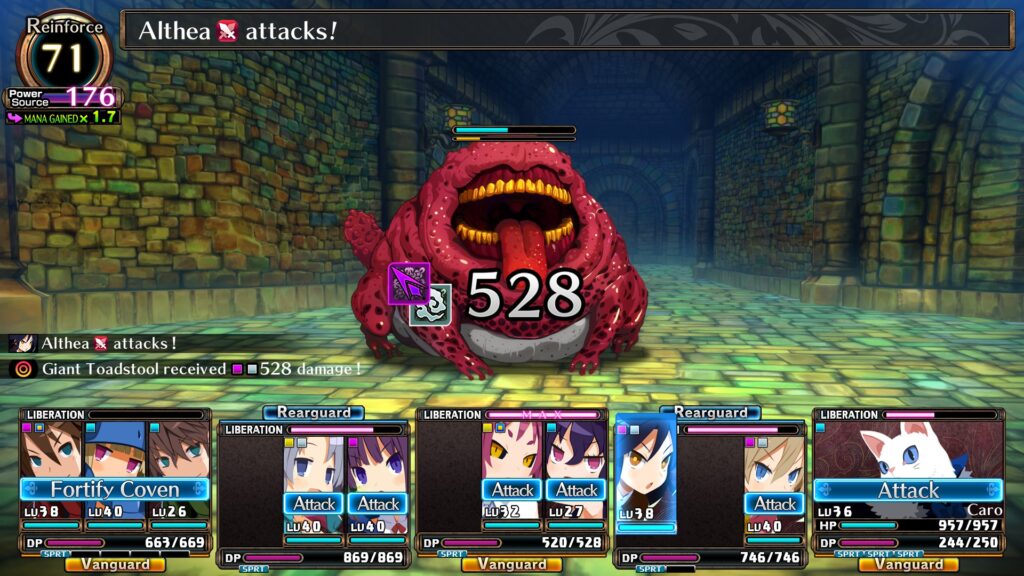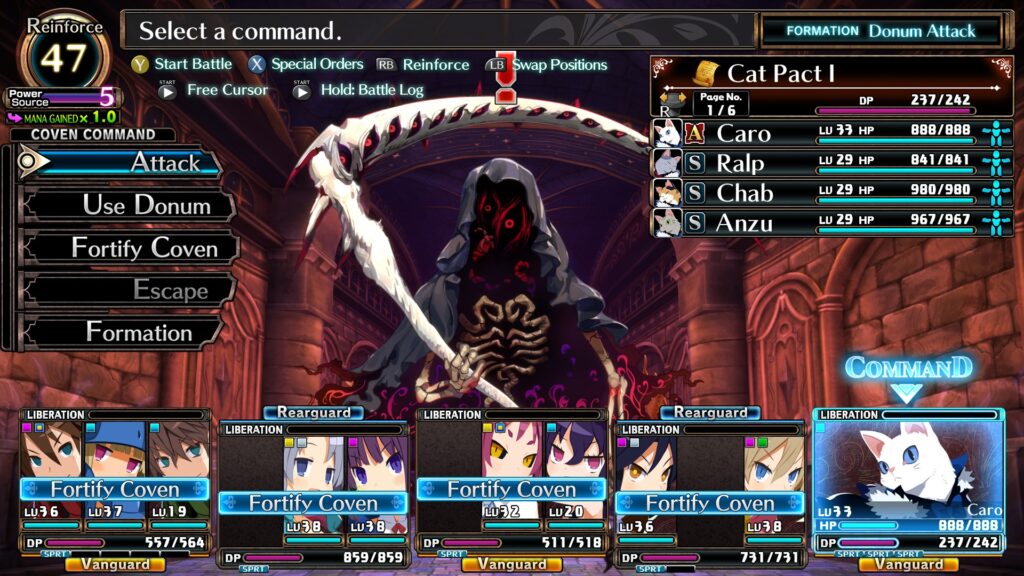Labyrinth of Galleria: The Moon Society is the sequel to Labyrinth of Refrain that combines dungeon crawling gameplay with the absurd level of systems and progression seen in a Disgaea title, with the recent PC release, this is the second, and final entry in the series for now, ported from the PSP Vita to other platforms. This is a bigger, better sequel that you owe yourself to check out if you enjoy dungeon crawling.
Puppet Power
The story itself is a soft reboot of the franchise — taking place in an entirely different world, with different characters. The main plot point does carry over, we play as a spirit who has been summoned by witches in order to brave a massive dungeon underneath a decrypted estate. Hidden in this dungeon are magical devices known as curios, and it’s up to us, our puppet soldiers, and a lot of gear to save the day.

The combat can get very swingy if you’re not paying attention to things
The dungeon is 100% linear, as you will explore floor by floor and biome by biome to find different treasures.
Once again, you’ll build a party out of puppet soldiers made up of different facets or classes, and assign them to brigades. Combat will rely on you making good use of your characters, equipping with them the best gear, and using the game’s other systems to boost your characters further.
Where Galleria excels compared to the first game is with making the actual dungeon crawling far more exciting.
Metroidvania Crawling
The first game had several interactable powers you could use, such as setting up fast travel portals and breaking down walls. Galleria takes this further with an almost metroidvania-like progression. You’ll find far more environmental hazards like going underwater to deal with. As you complete the story events, you’ll gain the ability to go through hazards and travel around the dungeon differently. This opens new areas on the previous floors and will make your life a lot easier. This becomes a huge gameplay point when you are trying to track down curios that you missed on earlier floors.
One of the best upgrades added to this game is the ability to now set up floor-specific portals that you can use to quickly get from stairwell to stairwell, eliminating the time redoing sections of a floor. Even though dungeon crawling is far more dangerous, you still have a variety of enemies and situations to deal with.
Tactics-based Combat
The combat system in Galleria has received a few updates compared to Refrain. Your main source of interaction — using reinforcement points or RP, to boost your characters returns. There are now special abilities tied to the various brigade pacts, giving them a bit more variety, along with new tactical options you can deploy.
The enemies once again run the gambit from tiny, to massive, from cute, to outright weird-looking for you to fight. There are still plenty of bosses and elite encounters to go through. As with the first game, your difficulty in combat will depend on how you are outfitting your characters, your formations, and what gear you were able to find.
A lot of the items in the game are randomly generated, and this can tremendously affect the potential of your soldiers. In my play, using the equipment combining system, I was able to boost one spear to the point that I didn’t need to change it for over 15 hours of play. Speaking of hours, this is a long game, even more so for those willing to go for the true ending, and the game throws one heck of a curveball that I want to spoil, because it’s so interesting for a dungeon crawler, but at the same time, I don’t want to reveal the twist here.
A Galleria of a Time
Labyrinth of Galleria: The Moon Society is pound for pound better than the first game. I have a few complaints. For a nitpick, is that it starts out a bit harder than the first one — throwing harder enemies and making it tricker to build a full team right out of the get-go. But once you get past that, you’re either going to be all in or all out for the rest of the game. The most annoying ability that is going to follow you throughout the entire game is enemies that can counter your party, and if someone knows an easy way of dealing with them beyond just bursting them down, I would love to hear it.

Why Do I hear “Roundabout” Playing?
In terms of the level design, I liked the themed design of the first game a bit more than in this one.
Each one of the biomes in Refrain had its own structure, challenges, and a bit of a story to them. In this one, the dungeon itself is not as much a part of the story in the same respect.
This game is far more story-structured compared to the first, which may be surprising for fans of dungeon crawlers. Going for the true ending is going to take quite a lot of story twists and turns, and the middle portion of the game before the final area does feel like a bit of a slog. I won’t say how you get there, but when the game introduces randomly generated floors, it does slow down quite a bit. I do miss the more structured biomes of the first game, and those do come back to some extent in the back half, but by the time you get there, it is more than likely you are going to be committed to seeing the game all the way through to the very end. And trust me when I say that this game is loooooooooooooooooong, if you thought getting the true ending in Refrain was the longest this series could go, that was a short walk compared to the lengths of this game. And I do hope that if this continues, the developers move away from random item farming as part of the progression gates to see everything the game has to offer.
The developers truly know who their audience is, and if you’re someone looking to go through some dungeons, power up your characters to obscene levels, and get a surprisingly sweet, dark, disturbing, and interesting, story as well, this is an easy recommendation to play.
This was played with a press key supplied by the developer.
- If you would like me to consult with you on your design or playtest your game, please reach out
- If you enjoyed this story, consider joining the Game-Wisdom Discord channel. It’s open to everyone.

